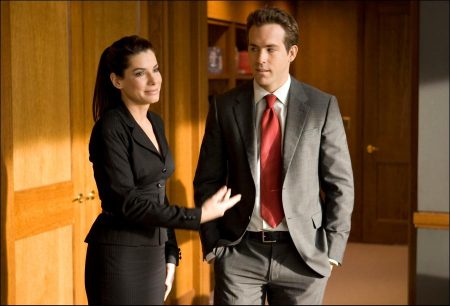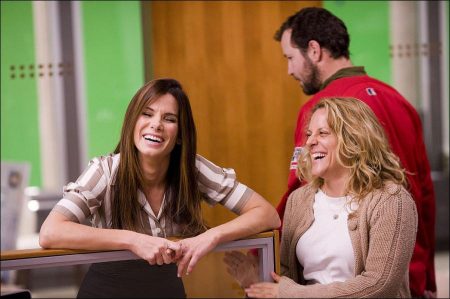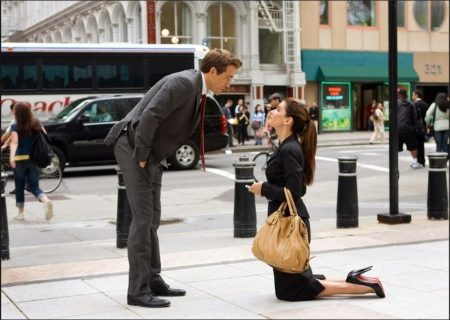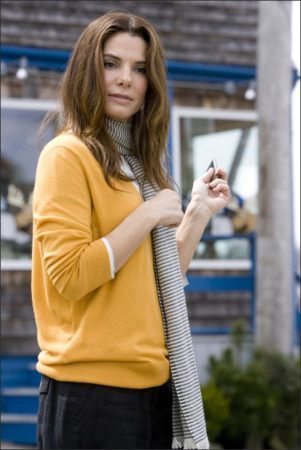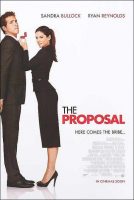Casting Chemistry: Filmmakers Assemble a Perfect “Proposal”
The Proposal Movie Trailer. Filmmakers tapped Sandra Bullock early on for the role of Margaret. “She’s really fun to play, because she’s in all of us,” says Bullock. “Margaret doesn’t try and rectify any of the wrongs. She doesn’t apologize. She doesn’t feel like she has to make the world like her. She has a job to do, and she’s gonna get it done. And there’s a large part of me in that.”
“I feel really lucky that we got her,” says producer Todd Lieberman of Bullock. “She’s a phenomenal actress and she can do any role, but she’s so good and naturally gifted at comedy. People love her even when she’s playing someone who’s as hard edged as the character Margaret.”
Fletcher was equally impressed by Bullock. “She’s a movie star,” says the director. “She comes to work, she knows why she’s there, she gets the job done. And her chemistry with Ryan is bar none.”
Ryan Reynolds portrays the put-upon assistant who ultimately turns the tables on his boss. And with the majority of his scenes opposite Bullock, chemistry was imperative.
“They have a rhythm, they have a friendship, they have a way of communicating with each other-a sort of banter, a give and take,” says Hoberman of Bullock and Reynolds. “They found a groove in these two characters that really came to life.”
“Sandy and I’ve been friends for years-it’s great working with your friend,” says Reynolds. “My experience in a comedy is that you shoot the film and then halfway through you start to understand what your chemistry is with your costar and you wish you could go back and re-shoot all that you’ve already done. When you step on a set the first day and you already have that chemistry built in as Sandy and I did, you never experience that.”
Lieberman says both actors have “complete command of what it means to be funny. We have scenes with the camera on Ryan’s face. He doesn’t say a word, but he expresses 100 different funny things. It’s unbelievable.”
Supporting Bullock and Reynolds is a stellar group of actors. “It’s a testament to the great script and our two strong leads that we were able to put together such a great group of people,” says Lieberman.
Nearly stealing the show is Betty White as Andrew’s grandmother “Gammy” Annie. “She’s turning 90 and has spent most of her life in Sitka, Alaska,” says Chiarelli of White’s character. “She’s a tough woman who recognizes the toughness in Margaret, and she likes what she sees. So even though on the surface she and Margaret share little, they actually have everything in common.”
“Audiences are so in love with Betty White,” says Fletcher. “She is so comfortable on screen-a television icon. She just has a quality about her that you love as a person and on screen.”
Oscar Nuñez steps in as Ramone, a Sitka local who seems to have a myriad of different professions, including male stripper. “Oscar’s level of commitment is outrageous,” says Fletcher. “You can’t take your eyes off of him and you fall madly in love with him.”
Tony Award winner Denis O’Hare plays Gilbertson, the immigration official who is determined to prove the impromptu engagement a charade. “We read lots and lots of Gilbertsons,” says Lieberman. “Denis was the one guy who really got it. He gave a perfect blend of government officious and vulnerability so that you could laugh at the guy. The scenes in the INS building were great fun between him and Ryan and Sandy.”
In an effort to convince Gilbertson that their engagement is real, Margaret and Andrew travel to Sitka, Alaska to spend the weekend with Andrew’s family. “All families are screwed up,” says Bullock. “I don’t care how good they look on the outside, there’s always a dynamic that is strained. Fathers and sons will battle, as will mothers and daughters, and this film is very much about that. This family is so complex, but so loving and open, that Margaret is overwhelmed by it. The minute you see these people on screen, you realize that something’s going on here. They’ll fight it out, but they’ll still remain family.”
For Bullock, “Mary Steenburgen can balance the drama with the comedy. With just the smallest word she can tear up a scene or make you cry. Mary seems delicate, but she’s not. Behind the fragility she’s so mischievous and so aware of what she’s doing. To be able to do that in comedies, and make it real, is very difficult.”
Fletcher turned to a familiar face when it came to casting Gertrude, the effervescent young woman Andrew left behind when he went to StateplaceNew York. Malin Akerman, who starred in Fletcher’s “27 Dresses,” plays what just may be a serious romantic threat to Margaret.
“Gertrude has come to realize that Andrew was the best thing that ever happened to her,” says Akerman. “It’s one of those things-you let someone go and then you realize it was a mistake. Now it’s hard watching him with this new woman.
“I’ve played a lot of crazy, wacky characters in the past,” continues Akerman, “so it’s nice just to be a sweet, lovely kind of girl.”
Rounding out the cast is Aasif Mandvi as Bob Spaulding, Margaret’s contentious colleague, and Michael Nouri and Gregg Edelman as Margaret’s employers who deliver the deportation news.
The Director’s Chair: Anne Fletcher Takes the Lead
At the helm of “The Proposal” is Anne Fletcher, the former dancer and choreographer whose first directorial effort was the 2006 hit “Step Up.” Fletcher solidified her reputation as an inspired and confident director with the international box-office success “27 Dresses,” starring Katherine Heigl, James Marsden, Ed Burns and “The Proposal’s” Malin Akerman.
Known and appreciated by cast and crew for her great spirit, irreverence and the way she would literally dance onto a set, Fletcher is as meticulous as she is energetic. Fletcher sees her work as a choreographer as preparing her for her role as a director.
“Choreographers for film choreograph for the camera, not the stage,” she says. “We’re thinking about all the different angles. I used to break down the characters, read the whole script to figure out why are these people dancing? Where do they come from and where are they going that they have to dance? Does the dance further the story? So you’re kind of doing the leg work that a director does. You’re understanding where the camera needs to go, what helps to make the scene look dynamic or small. I think it helps having that eye and understanding that things need to move to be interesting.”
“Anne’s energy is physical,” says veteran director of photography Oliver Stapleton. “Her background is choreography and dance, so her intuition and sensibility are based on something extremely earthy, which isn’t very common in directors. Most directors are very intellectual people who tend to exist from the neck up while some others exist all in the heart. I’ve never worked with a director who springboards from her physicality. Anne has a very unique way of choreographing the actors, and I don’t just mean the physical movement of `you walk from A to B,’ but rather having an incredibly clear sense of how a scene works.”
“Her energy is endless,” Bullock says. “But that’s only surpassed by how great she is at her job as a director. It’s been a long time since I’ve worked with someone who was as thorough, as thought-out and as good at her job as Anne is. I’m so happy to come to set, because I know that if I do my work, she will have done it a thousand times better. She knows the ins and outs of everyone’s role and doesn’t allow anyone to go too far. If you’re stuck, she knows exactly what it takes to bring you out of it. As a director, she’s the real thing.”
Getting Dressed
Margaret’s high-fashion, knock-out business attire is, says Bullock, “her armor-the tighter, more severe, cinched and hardened, the better. She knows she looks good, but her clothes are not primarily intended to make her look good. She’s used to having things constricted and strong so she can keep herself contained. If you take her out of that armor, she unravels.”
Costume designer Catherine Marie (Cat) Thomas called on decades past to develop Margaret’s wardrobe. “I was inspired to do this very structured ’40s silhouette because Margaret’s very uptight and regimented, and Sandy was thrilled,” says Thomas. “So our departure point was the silhouette of the ’40s, as worn by Katharine Hepburn and Rosalind Russell. Sandy’s got great legs so you can do a pencil skirt up to the knee, but we purposely made them longer so that she would be more nipped in and would have to alter the way she walked. She loves that. She is so physical. She didn’t have to wear four-inch heels, either, but she said, `No, it’s great!’ because, as much pain as she may have been in, it made her walk and stand differently.
“There was nothing that we could pull from a department store,” Thomas continues. “Designing for Margaret was about building every piece of clothing for this powerful woman who is very confined. Everything was about her power, yet had to be feminine at the same time.”
Thomas particularly liked putting together Margaret’s wedding attire since the script indicated Margaret would be wearing Gammy’s dress. “It’s a late `20s early `30s sort of biased gown look,” says Thomas. “It’s pretty unique and Sandy and I were excited about the dress because it’s different than most wedding gowns.”
Ryan Reynolds’ character had two distinct looks, says Thomas. “Anne Fletcher and I talked about how Andrew is that sort of effortlessly sexy guy. Although his family has money, he’s really trying to prove himself, so at work his look is very professional. But when he and Margaret leave for their weekend he’s totally prepared with jeans, T-shirt and a jacket because, of course, he knows that CityplaceSitka is very casual, very comfortable. Margaret is in a dress and high heels-there’s quite the contrast.”
Thomas had more of a challenge dressing-or rather undressing-Oscar Nuñez’s Ramon, who does a scene as a male stripper. “Anne had this sort of 1980s reference-a guy who used to strip in the late ’80s and never let it go. So in addition to breakaway clothing, the little bowtie and the cuffs, we added his ’80s Reeboks jazzercise shoes. Oh, and the knee pads. That was another nice touch.”
Discovering Alaska-in Massachussets
Except for day of exteriors in New York City, “The Proposal” was shot almost entirely in the state of Massachusetts. The filmmakers were pleased to find great locations along the rocky shores north of Boston in the towns of Rockport, Manchester-by-the-Sea and Gloucester, and on Cape Ann-all needing relatively minor adjustments to be transformed into the small Alaskan town of Sitka.
“The script was written to take place in Sitka, because Pete, the writer, had spent a summer there and knew the town pretty intimately,” says producer Lieberman. “I thought it would be a great setting that we haven’t really seen before, especially in a comedy.”
While their Massachusetts locations were extraordinary, production designer Nelson Coates still had his work cut out for him. “Anne and I were particular about making our Alaska feel as if you were really there by making it evocative instead of trying to mimic it exactly,” says Coates. “But to turn the town of Rockport into Sitka, we had to deal with almost 30 storefronts, their window dressing and signage; it was fairly extensive. It felt more like working on a period movie where you have to cover so much to create a sense of place.”
One of the filmmakers’ greatest finds was the magnificent home along the coast in Manchester-by-the-Sea that would become the Paxton estate. Little was required to dress the exterior of the house except for the addition of First Nation art, including totem poles, and building an enclosure over a large swimming pool that would become the planned site for Margaret and Andrew’s wedding.
“One of the things that is very particular about that part of the world, from British Columbia all the way into the Panhandle of Alaska, is the First Nations tribes,” says Coates. “Early on, Anne and I talked about incorporating their very specific paintings and carvings, especially because our Betty White character has Tlingit heritage.”
But the interior of the house, built in the early 20th century and distinguished by a bright, Early American decor, proved a challenge. Using the existing floor plan, Coates designed new rooms of dark wood tones and stone walls with a fireplace that would be more evocative of the Pacific Northwest.
“One of the things that makes this particular area of Massachusetts so similar to Alaska and a great place to shoot is the rocky coast and the feeling of isolation that you get with some of the houses,” says Coates. “Since almost three weeks of our filming takes place at the Paxton house, we needed something that felt like it was on an island, and this house is on a peninsula, so we can get that feel of the water. And because of the rocky nature of the coast, it really does feel like it is in the Sitka area where a lot of the mountains are plunging right into the water.”
Filmmakers bridged the gap between the Massachusetts exterior and the real Sitka by traveling to Alaska to capture the mountainous, tree-filled area on film.
The Proposal (2009)
Directed by: Anne Fletcher
Starring by: Sandra Bullock, Ryan Reynolds, Malin Akerman, Craig T. Nelson, Mary Steenburgen, Betty White, Aasif Mandvi, Michael Nouri, Kortney Adams, Alicia Hunt, Alexis Garcia, Denis O’Hare
Screenplay by: Peter Chiarelli
Production Design by: Nelson Coates
Cinematography by: Oliver Stapleton
Film Editing by: Priscilla Nedd-Friendly
Costume Design by: Catherine Marie Thomas
Set Decoration by: Denise Pizzini
Art Direction by: Scott Meehan
Music by: Aaron Zigman
MPAA Rating: PG-13 for sexual content, nudity and language.
Distributed by: Touchstone Pictures
Release Date: June 19, 2009
Views: 236
